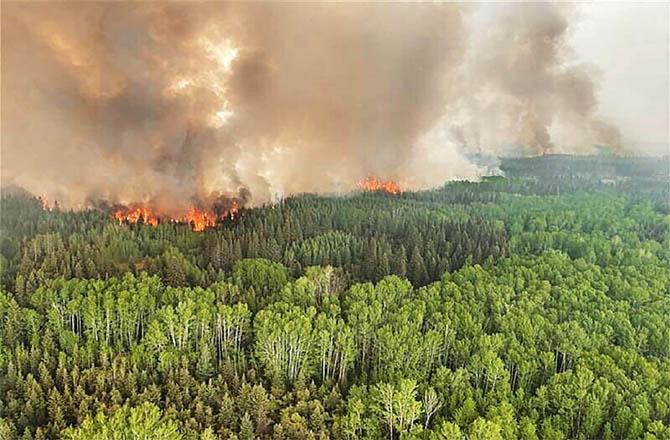This year’s fire emissions are more than double compared to 2014, 9 years ago it was 138 and this year it was 290 megatons. Record-breaking carbon emissions from Canadian forest fires.
The European Union’s climate watchdog said last year’s large-scale fires in Canada’s forests have doubled the 2014 carbon emissions record, and there are fears the fires will continue to engulf the forests for weeks or months. According to the AFP report, this devastating fire in Canada has spread over 3 million acres this year, which is more than the total area of Cuba and South Korea. According to the report, the air of Canada has become the most polluted due to the smoke from the fire. And because of this, air pollution has become uncontrollable in the neighboring United States, where more than 10 million people have been affected so far, flights are being canceled and outdoor events are being avoided.
Europe’s Copernicus Atmospheric Monitoring Service (CAMS) said it had detected the fires in early May, after the season had started, and had by then spread widely across the country.
CAMS said that the previous highest emissions of smog into the atmosphere were recorded in 2014, but at the end of July, total carbon emissions had more than doubled compared to 2014. Mark Parrington, a senior scientist at CAMS, said: “Smoke emissions continue to increase at a rate that is expected to break the record for overall fire emissions in Canada on an annual basis in our data,” he said. Pollutant emissions from fires are the highest, so it is feared that these figures will increase in the next few weeks, for which we will continue our monitoring. Record-breaking carbon emissions from Canadian forest fires
According to the report, fire incidents in the northern regions usually start in May, which continues until October, during which it intensifies in July and August, both of which are the hottest and driest months of the year in Canada. This year, along with the large-scale fires in Canada, the forests of Russia have also come under fire. Record-breaking carbon emissions from Canadian forest fires
CAMS said in a statement that recent forest fires have been moving further north, including the Arctic Circle, which will produce large amounts of smoke. said that currently the total carbon emissions from forest fires in Canada is about 290 megatons while the previous record was 138 megatons in 2014. Record-breaking carbon emissions from Canadian forest fires.
Canada is already one of the fastest-warming regions in the world, while climate change has increased the number and severity of extreme weather events the country faces. Record-breaking carbon emissions from Canadian forest fires.
Canadian forest fires can indeed have a significant impact on carbon emissions. When forests burn, they release carbon dioxide (CO2) and other greenhouse gases into the atmosphere, contributing to carbon emissions and, subsequently, climate change. Here are some key points to consider regarding carbon emissions from Canadian forest fires:
- Natural Part of the Carbon Cycle: Fires, including forest fires, are a natural part of the carbon cycle. Forests store carbon in trees and vegetation, and when they burn, this stored carbon is released back into the atmosphere.
- Variability in Emissions: The amount of carbon emissions from Canadian forest fires can vary significantly from year to year. Factors such as the size and intensity of fires, the type of vegetation burning, and weather conditions all influence the amount of carbon released.
- Contribution to Global Emissions: While Canadian forest fires can release substantial amounts of carbon, they are just one of many sources of carbon emissions worldwide. Industrial processes, transportation, and energy production are also major contributors to global carbon emissions.
- Impact on Climate Change: The release of carbon from forest fires contributes to the overall increase in atmospheric CO2 levels, which is a primary driver of climate change. Rising temperatures and changing weather patterns can, in turn, influence the frequency and severity of forest fires.
- Mitigation Efforts: Canada, like other countries, has measures in place to manage and mitigate the impact of forest fires. This includes fire management strategies, early warning systems, and efforts to reduce emissions from other sectors to counterbalance the impact of wildfires.
- Research and Monitoring: Scientists and researchers monitor forest fires and their emissions closely. They use satellite data, ground measurements, and computer models to estimate the carbon emissions from specific fire events and to better understand the long-term implications for the climate. Record-breaking carbon emissions from Canadian forest fires.
It’s important to note that forest fires can have both short-term and long-term impacts on the environment. While they release carbon in the short term, forests also have the potential to sequester carbon when they regrow, which can help offset some of the emissions. Record-breaking carbon emissions from Canadian forest fires.
The management of forest fires and efforts to reduce carbon emissions from all sources are critical components of addressing climate change. Record-breaking carbon emissions from Canadian forest fires.




